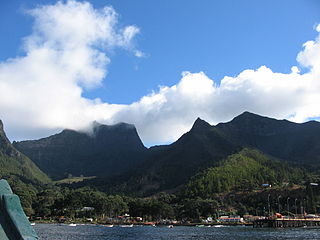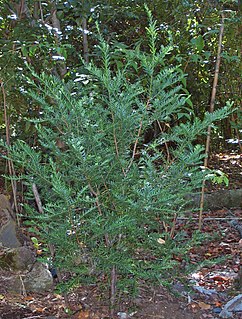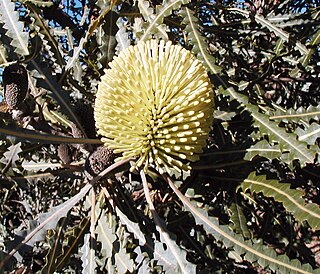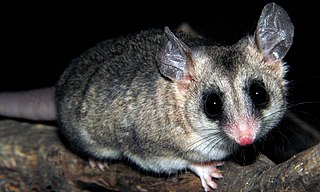
Chile, officially the Republic of Chile, is a South American country occupying a long, narrow strip of land between the Andes to the east and the Pacific Ocean to the west. It borders Peru to the north, Bolivia to the northeast, Argentina to the east, and the Drake Passage in the far south. Chilean territory includes the Pacific islands of Juan Fernández, Salas y Gómez, Desventuradas, and Easter Island in Oceania. Chile also claims about 1,250,000 square kilometres (480,000 sq mi) of Antarctica under the Chilean Antarctic Territory.

The Juan Fernández Islands are a sparsely inhabited island group in the South Pacific Ocean reliant on tourism and fishing. Situated 670 km off the coast of Chile, they are composed of three main volcanic islands: Robinson Crusoe, Alejandro Selkirk and Santa Clara. The group is considered part of Insular Chile.

Flora is all the plant life present in a particular region or time, generally the naturally occurring (indigenous) native plants. The corresponding term for animal life is fauna. Flora, fauna, and other forms of life, such as fungi, are collectively referred to as biota. Sometimes bacteria and fungi are also referred to as flora, as in the terms gut flora or skin flora.

Prumnopitys andina, the lleuque or Chilean plum yew, is an evergreen coniferous tree native to south-central Chile and a few areas in adjacent parts of westernmost Argentina from 36 to 40° South latitude. It lives on moderately wet soils, preferably on Andean slopes from 500–1,100 meters (1,600–3,600 ft).

Nothofagus pumilio is a deciduous tree or shrub in the Nothofagaceae family that is native to the southern Andes range, in the temperate forests of Chile and Argentina to Tierra del Fuego, from 35° to 56° South latitude. This tree is in the same genus as the coihue. It regenerates easily after fires. The wood is of good quality, moderate durability, and is easy to work with. It is used in furniture, shingles and construction and sometimes as a substitute for American black cherry in the manufacturing of cabinets.

Banksia elegans, commonly known as the elegant banksia, is a species of woody shrub in the genus Banksia of the family Proteaceae. Reaching 4 m (13 ft) high, it is a suckering shrub which rarely reproduces by seed. The round to oval yellow flower spikes appear in spring and summer. Swiss botanist Carl Meissner described Banksia elegans in 1856. It is most closely related to the three species in the subgenus Isostylis. It occurs only over a 65 square kilometre area north and west of Eneabba, Western Australia.

The elegant fat-tailed mouse opossum, also known as the Chilean mouse opossum, is an opossum from central Chile. The type species of Thylamys, it was first described by English naturalist George Robert Waterhouse in 1839. This medium-sized opossum is characterized by black rings around the eyes, white limbs, gray to light brown coat, lighter flanks and underbelly and a thick 12.7–14.6 centimetres (5.0–5.7 in) long tail covered with hairs. It is crepuscular and lives in nests in tree hollows or under rocks and roots. This opossum feeds mainly on arthropods and larvae apart from fruits. Litter size is typically between 11 and 13. The elegant fat-tailed opossum can occur in a variety of habitats – from cloud forests to chaparrals. The IUCN classifies the opossum as least concern.

Eudromia is a genus of birds in the tinamou family. This genus comprises two crested members of this South American family.

Gutierrezia is a genus of flowering plants in the sunflower family, native to western North America and western South America. Plants of this genus are known generally as snakeweeds or matchweeds. Some species have been called greasewood. They are annual or perennial plants or subshrubs with yellow or white flowers.

Gevuina avellana is an evergreen tree, up to 20 meters tall. It is the only species currently classified in the genus Gevuina. It is native to southern Chile and adjacent valleys in Argentina. It is found from sea level to 700 meters above sea level. Its distribution extends from 35° to 44° south latitude. The composite leaves are bright green and toothed, and the tree is in flower between July and November. The flowers are very small and beige to whitish, are bisexual and group two by two in long racemes. The fruit is a dark red nut when young and turns black. The peel is woody. It can grow up straight or branched from the soil, making up either s tree or a shrub.

Enneapogon is a cosmopolitan genus of plants in the grass family.

Calochortus elegans is a species of flowering plant in the lily family known by the common name elegant Mariposa lily, cat's ear, elegant cat's ears or star tulip. It is native to the western United States from northern California to Montana.
Pachylaena is a genus of South American flowering plants in the gerbera tribe within the daisy family.

Zinnia elegans, known as youth-and-age, common zinnia or elegant zinnia, an annual flowering plant of the genus Zinnia, is one of the best known zinnias. It is native to Mexico but grown as an ornamental in many places and naturalised in several places including scattered locations in South and Central America, the West Indies, the United States, Australia, and Italy.
Chaetanthera elegans is a flowering plant species in the genus Chaetanthera found in Chile.
Cristaria is a genus of freshwater mussels or pearl mussels, aquatic bivalve mollusks in the family Unionidae.
Cristaria is a plant genus in the family Malvaceae containing 20-30 species native to South America.
Platnickia elegans is a species of spiders in the Zodariidae family. It is found in Chile and Argentina.
Adesmia elegans is a species of legumes. It is found in Chile.
Pilea elegans is a species in the plant family Urticaceae. It is found in Chile. USDA hardiness zone 9. The plant does not tolerate snow, but can tolerate occasional freezing spells of about -5 degrees C. Light requirements consist of indirect light/low light Can bee found in deep ravines in Chile facing south with additional shadow from trees, or where there is a very dense vegetation cover which gives 80 - 100 % shadow












